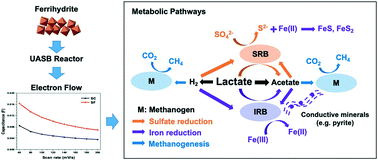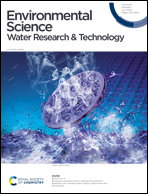Insight into ferrihydrite effects on methanogenesis in UASB reactors treating high sulfate wastewater: reactor performance and microbial community†
Abstract
Sulfate reduction may inhibit methane production during anaerobic treatment of sulfate-containing wastewater. The purpose of this study was to establish direct interspecies electron transfer (DIET) between iron-reducing bacteria (IRB) and methanogens with Fe oxides to alleviate the inhibition of sulfate in anaerobic digestion. Effects of ferrihydrite on the digestion performances with various sulfate concentrations (1034 mg L−1, 1551 mg L−1, and 3171 mg L−1) were investigated in this study. Results showed that addition of ferrihydrite decreased methane production but enhanced sulfate reduction (P < 0.05) at low concentrations of influent sulfate since ferrihydrite alleviated the inhibition to cause sulfate reducing bacteria to outcompete methanogens for capturing electrons. When increasing the influent sulfate to 3171 mg L−1 with a COD/SO42− ratio of 0.54, ferrihydrite increased methane production (P < 0.05) because IRB enriched with ferrihydrite might couple with methanogens to cause DIET for methanogenesis. Ferrihydrite increased the secretion of humic acid-like substances of EPS to enhance electron transfer capacity. During the process, conductive iron minerals such as pyrite were formed to promote the DIET. Accordingly, microbial community analysis revealed that IRB (e.g. Clostridium) were enriched in the presence of ferrihydrite.



 Please wait while we load your content...
Please wait while we load your content...